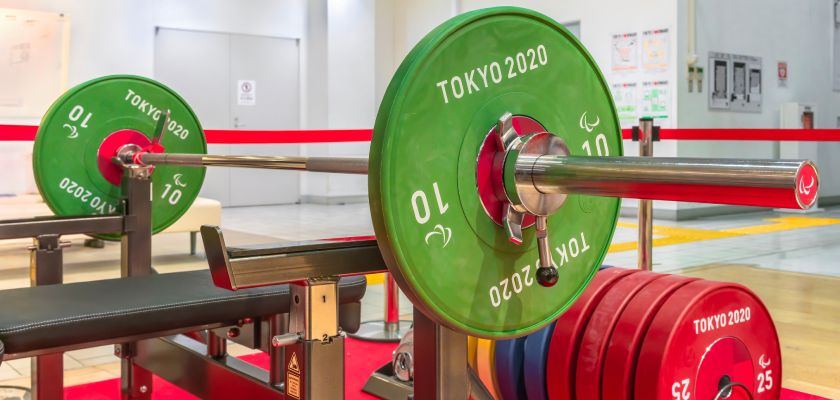In this complete guide, we’ve separated everything about paralympic weightlifting (also called paralympic weightlifting), a sport in which athletes must show a perfect union between strength and technique.
By way of comparison, Paralympic weightlifting is very similar to conventional weightlifting, but athletes are classified based on their disabilities to ensure fair competition.
In a nutshell, each athlete lies on a bench and has to lift the weight in a movement called the bench press. There are three attempts in all, and the highest weight lifted is considered the final result. Below, we’ll go into more detail about the sport itself.
Participate in our free Whatsapp community and receive daily tips, news and trivia from over 50 sports! Click here to join.
How does paralympic weightlifting work?
The movement of paralympic weightlifting is the same as that of traditional weightlifting: it focuses mainly on the chest muscles, but also involves the shoulders and triceps.
The athlete grips the bar with their hands a little wider than shoulder-width apart. With arms extended, the athlete needs to slowly lower the bar towards the chest, keeping the elbows slightly bent outwards.
The weightlifting movement becomes complete when the arms are fully extended and the bar is above the chest, in line with the shoulders. You can see in the video below how paralympic weightlifting works in practice:
What is the goal of paralympic weightlifting?
The objective of weightlifting, in both the conventional and paralympic versions, is to demonstrate strength and technique. The athlete needs to ensure that the movements are carried out efficiently and safely.
Everything about paralympic weightlifting: techniques
As well as strength, the sport requires mentality and strategy. That’s why athletes need to use techniques to improve their performance.
Strength Development
One of the pillars of success in weightlifting is the development of muscular strength. Athletes go through compound exercises such as squats, deadlifts and weightlifting itself to increase this fitness.
Stability and Balance
Maintaining a stable base and good balance is crucial to success in weightlifting, which involves a solid posture, a firm grip on the bar and control of the movement in all phases of the lift.
Mentality
Weightlifting requires high mental concentration and focus for each attempt. Athletes learn to block out distractions and concentrate fully on the lift, visualizing the movement before executing it.
Consistency
Success in weightlifting often comes down to consistency over time.
Everything about paralympic weightlifting: rankings
Paralympic weightlifting classifications are based on disability classes, which take into account the type and level of disability of each athlete.
Cerebral Palsy
Athletes with cerebral palsy can be classified into different classes, depending on the type and degree of impairment. Classifications range from P1 to P5, with P1 representing the highest degree of impairment and P5 representing the lowest. Some athletes with cerebral palsy can compete in combined classes, such as CP1-5.
Amputation
Meanwhile, athletes with limb amputations or similar disabilities are classified based on the type and level of amputation. The classifications range from P1 to P4, with P1 representing the highest degree of disability.
Athletes with amputations can compete in amputee-specific classes or in combined classes, depending on the type of amputation.

Spinal Cord Injury
Athletes with spinal cord injuries, such as paraplegia or tetraplegia, are classified based on the level of the injury and the degree of impairment. Classifications range from P1 to P5, with P1 representing the highest degree of impairment. Athletes with spinal cord injuries can compete in specific classes for wheelchair users or in combined classes, depending on the level of the injury.
The aim of this style of classification is to ensure a balanced competition, where athletes with different types and levels of disability can compete against each other in an appropriate manner.
Body weight
The competition is also divided into bodyweight categories. There are ten men’s and ten women’s categories. The weight categories are divided as follows:
- Male: -49kg, -54kg, -59kg, -65kg, -72kg, -80kg, -88kg, -97kg, -107kg e +107kg
- Female: -41kg, -45kg, -50kg, -55kg, -61kg, -67kg, -73kg, -79kg, -86kg e +86kg
Everything about paralympic weightlifting: history
The Paralympic movement itself began after the Second World War. The first Paralympic Games were held in 1948 in Stoke Mandeville, England, as a sporting event for injured war veterans.
Weightlifting was one of the disciplines included in the first Paralympic Games and quickly became an important part of the program.
Over the following decades, paralympic weightlifting gained popularity. More countries took part in the competitions.
As the paralympic movement grew, the next steps involved standardizing rules and regulations at an international level.
Paralympic weightlifting is now an integral part of the Paralympic Games, held every four years, along with a wide range of other sports. After all these years, it remains an opportunity for athletes with disabilities to demonstrate their physical abilities and compete in an inclusive and challenging environment.
And now that you know everything about paralympic weightlifting, how about continuing to explore our website and finding out about other disciplines? Check them out:



